Black mushrooms and fungi grow in woodlands, parks, gardens, and even on timber. Some species can have an all-black appearance while others are dominated by a dark black cap.
Some of the most widespread species are found West of The Rocky Mountains in North America as well as in the Eastern territories across woodlands and grassland.
In Europe, these mushrooms are associated with the mainland while some species also grow in Asia and Australia.
Sometimes edible depending on each species, black mushrooms have been associated with all types of myths back in the old days.
Today, they are an important indicator of the health status of an ecosystem as they provide essential nutrition to the habitat they grow in.
The following species are at least partly black if not all-black.
Table of Contents
1. Western Black Elfin Saddle
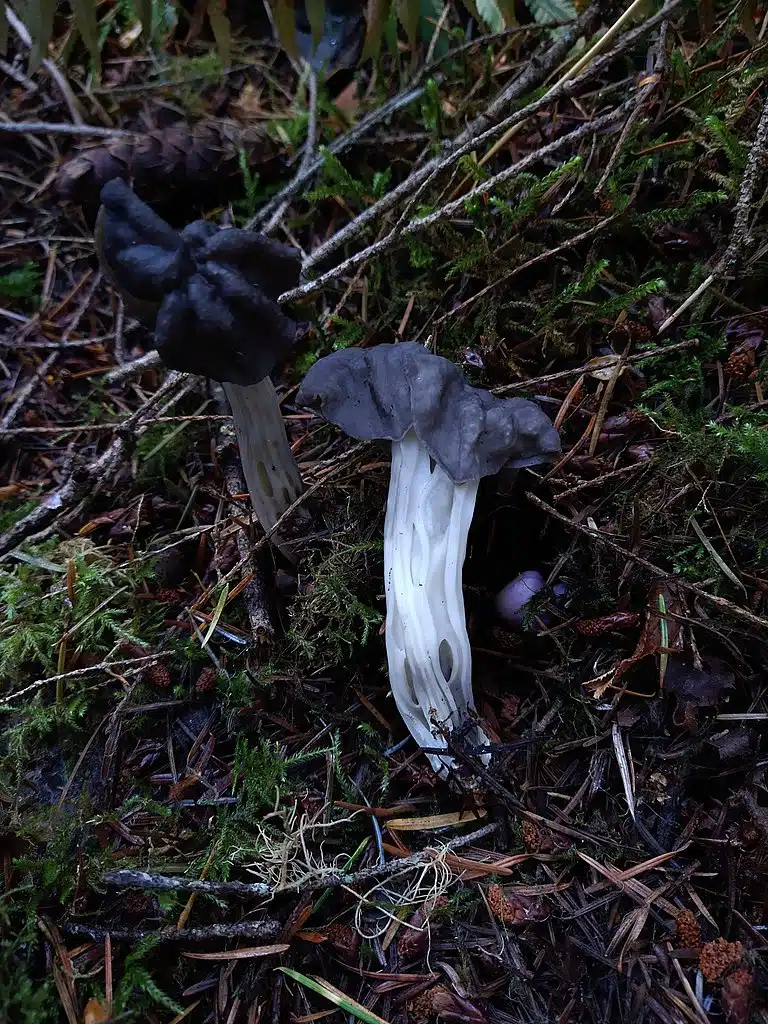
Black sections – cap
One of the most common black mushrooms of alpine areas is The Western Black Elfin Saddle (Helvella vespertina).
This is a species known for its black cap and white stipe with only rare exceptions of a white cap.
The shape of the cap is just as curious as well. It shows a wrinkly texture and a tendency to darken with time if gray at first.
Western Black Elfin Saddles have a cap of up to 2 inches with occasional sightings of larger mushrooms that measure up to 4 inches in diameter.
While mostly small, the cap itself can be eaten. Cooking it first is recommended, on the other hand.
However, they are not seen as worthwhile in many areas as there are reports of digestive issues tied to the species.
Some of the ideal territories of Western Black Elfin Saddles include high-elevation deciduous and coniferous woodlands.
These mushrooms grow in oak woodlands and under fir. Eastern North American forests are among the first places they can be found.
In many reports, only the ribbed stems of the species are described as the cap falls off for reproduction.
2. Devil’s Urn
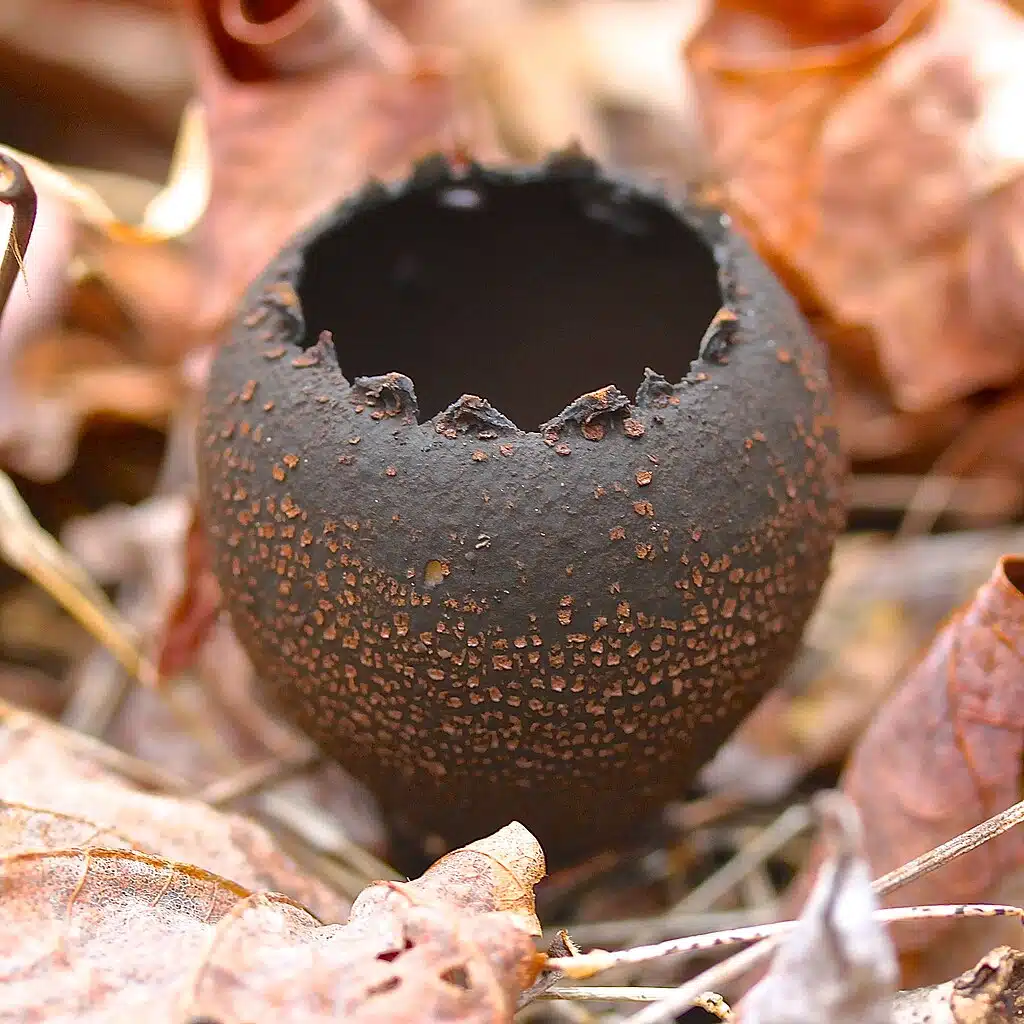
Black sections – outer ascocarp
Devil’s Urn (Urnula craterium) is almost completely black fungi that grows on oak.
The fungi grow on dead oak branches but only on those that are at least partly in contact with the ground and mostly on those already fallen on the ground.
A strong type of fungi, Devil’s Urn is known for inhibiting the growth of other types of fungi through its adverse effects.
When young, the fruit body of the fungi is closed, slowly opening up in a cup shape that’s mostly black and partly dark brown.
While it likes oak woodlands, Devil’s Urn fungi also grow on dead beech and other types of trees across different deciduous woodlands.
Its widespread distribution includes regions of Europe, North America, as well as East Asia.
While its poisonous status is unclear, the mushrooms fruiting bodies cannot be eaten as they’re hardy compared to other fungi.
3. Old-Man-of-the-Woods
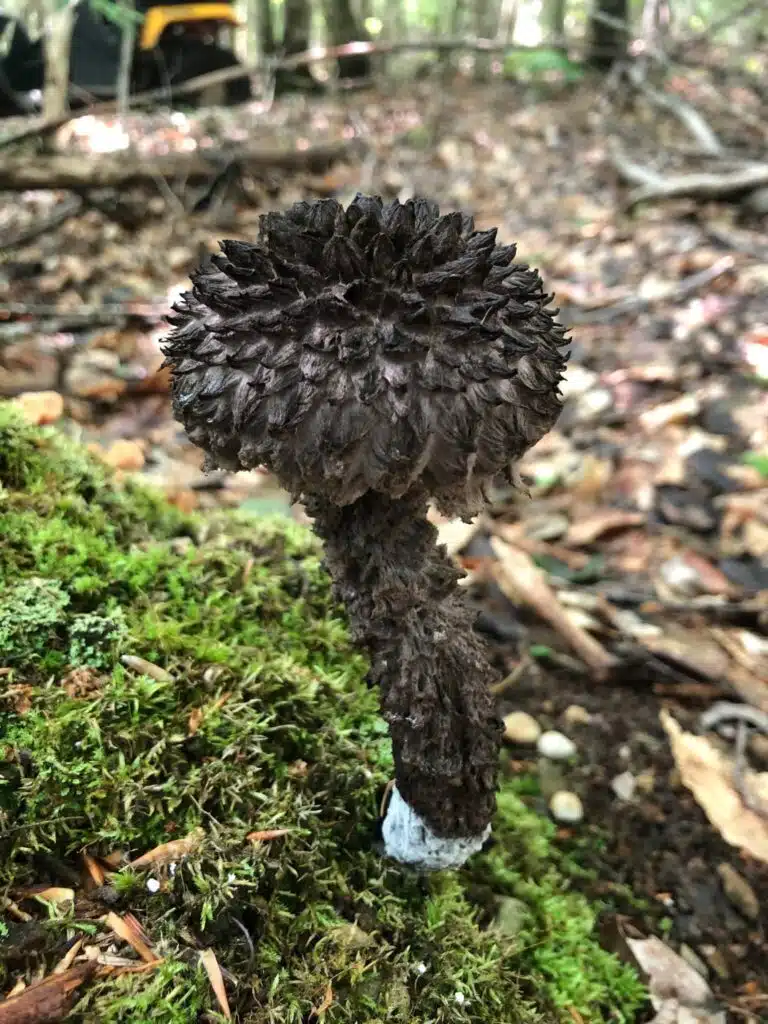
Black sections – cap scales, stipe
The end of the summer and the fall are the season’s Old-Man-of-the-Woods (Strobilomyces strobilaceus) is spotted in its temperate forests.
Mushrooms of this species are mostly specific to higher forests both of a deciduous nature and coniferous nature.
With a widespread presence from Iran to The United States, this is also a species with considerable black sections.
The cap shows multiple black spots on an almost white ground nuance.
Stipes are mostly black and covered in small flecks as well.
A dark type of mushroom, Old Man-of-the-Woods can be as wide as it is tall. It grows up to 5.5 inches in diameter and height.
The species is considered edible but it may be a rare sight even in coniferous woodlands.
4. Poor Man’s Licorice
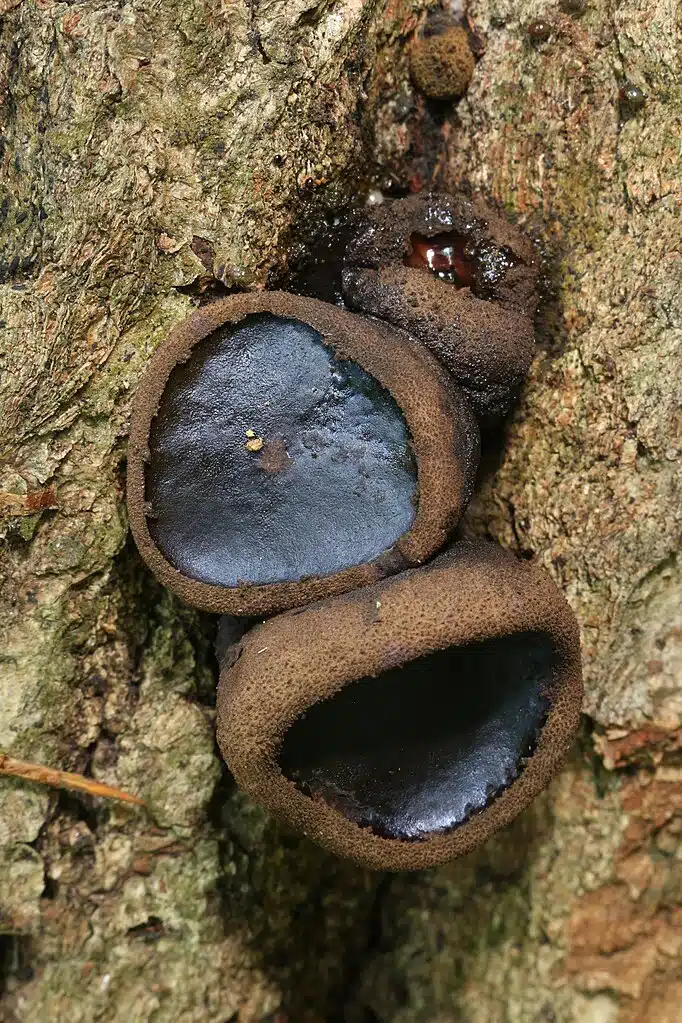
Black sections – outer fruit bodies
A common type of black fungi that grows on dead wood is represented by Poor Man’s Licorice (Bulgaria inquinans).
This is a species with a clear dark nature that varies from brown to dark brown and then black as the fungi grows.
Cup-shaped fruiting bodies grow on dead wood and are mostly black on the outside.
Its size varies considerably. From a cup of just 0.3 inches to a cup of almost 2 inches, its final size is variable.
This is also a species that shows the tendency to grow in clusters and changes its nuance from soft to harder depending on the rain levels.
Poor Man’s Licorice mainly grows around Europe, favoring dead trees on the continent.
Oak and ash trees are among its favorite species but this type of fungi also grows on old timber that’s left out in the rain. The fungi aren’t edible.
5. Oak-loving Elfin Saddle
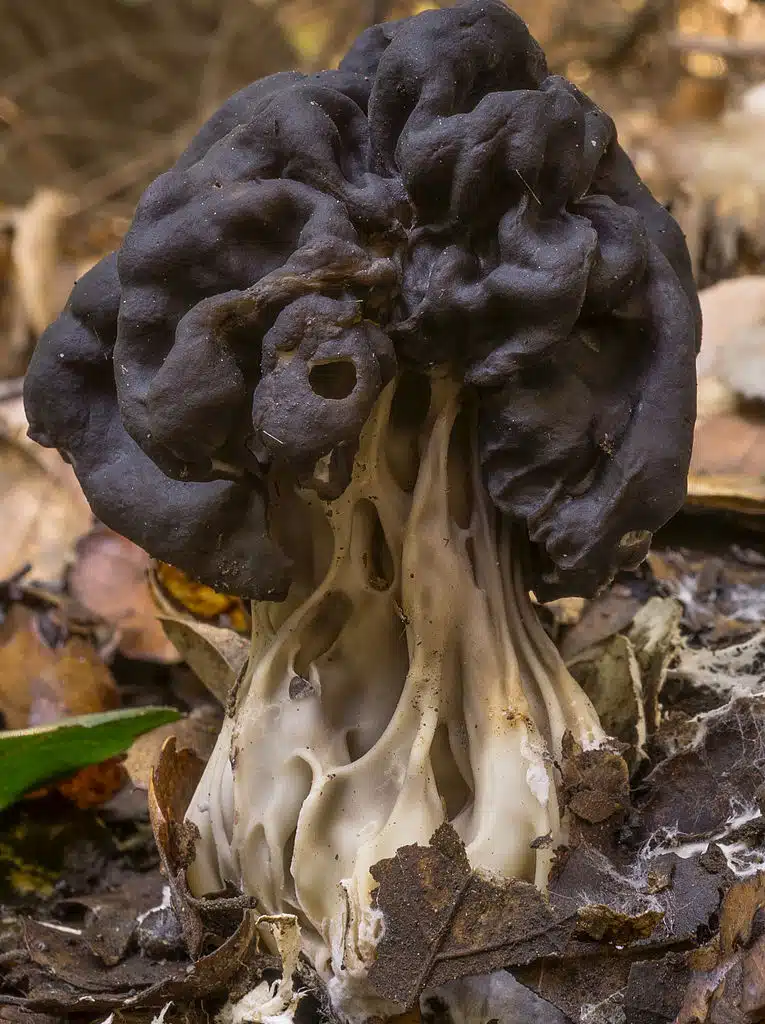
Black sections – cap
A dark and mostly black cap grows on the white stipe of The Oak-loving Elfin Saddle (Helvella dryophila).
This species shows a wrinkly cap with a globular shape which is always black as it grows.
Its white cone-shaped stipe contrasts the cap which grows to a diameter of around 3 inches.
The caps of the species have a rare type of waxy shape which has sometimes led to the comparison of the species with the shape of an ear.
Partly edible, this is a species that grows in coniferous and broadleaf woodlands.
It’s believed the cap can be eaten after cooking but there are reports showing the species is not edible and shouldn’t be picked.
Oak-loving Elfin Saddles have no distinguishing flavor or smell for them to be picked.
6. Dune Stinkhorn
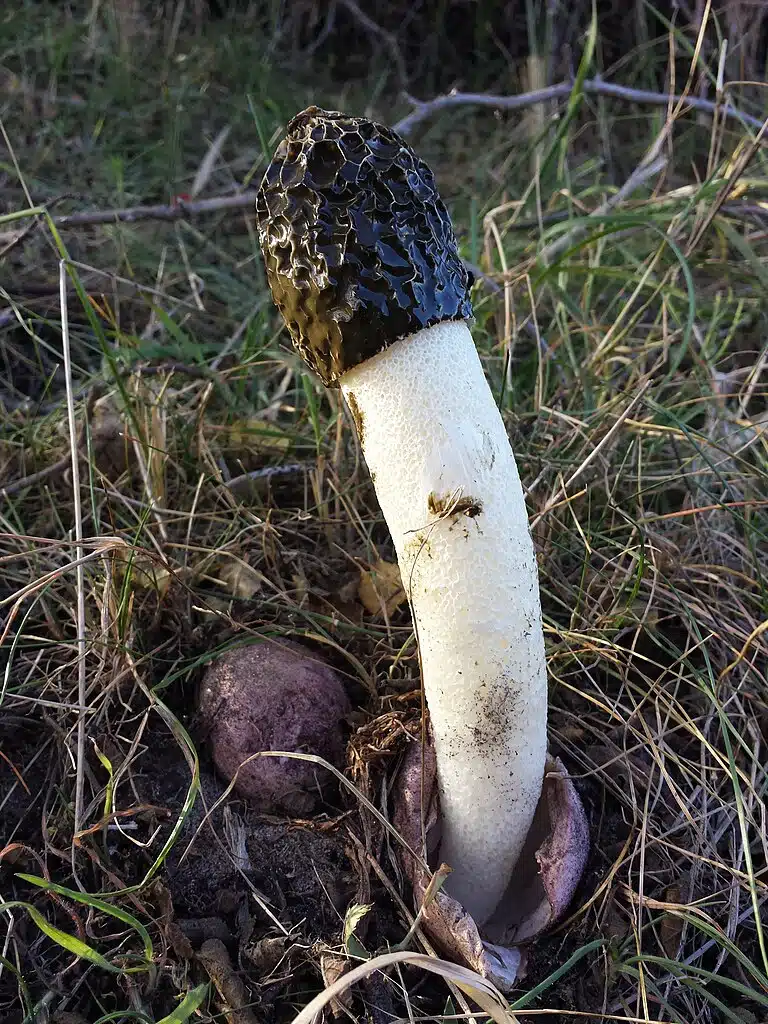
Black sections – gleba
Dune Stinkhorns (Phallus hadriani) eventually turn towards a black color of the gleba from an initial brown color.
This is a species with a common nature around the world as it has spread quickly.
Wood import exports are believed to have led to its quick expansion. Woodchips are a common type of material this species has spread across the continent.
The odor of the species is mostly unpleasant and even off-putting.
However, the odor of this stinky fungi may also be pleasant, depending on the season and its growth stages.
Its odor is more important than with other species as it relies on it to attract flies that spread its spores.
Furthermore, this is a species that typically needs a specific type of sandy habitat to spread and not a humid classic temperate forest habitat to spread.
Even protected by law in some countries, Dune Stinho9rns may be edible in its early growth stages.
7. Star-capped Coprinus
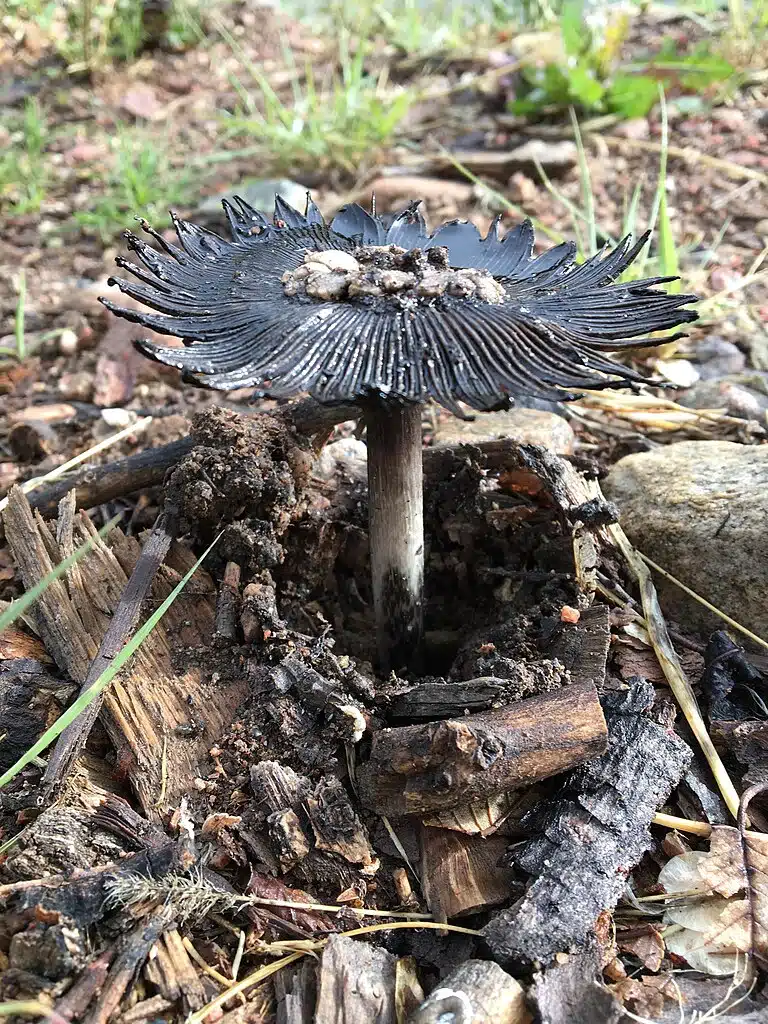
Black sections – gills
Initially egg and bell-shaped, Star-capped Coprinus (Coprinus calyptratus) are mushrooms that show their black gills as they grow.
This is a time when the cap itself starts to flatten out, with just its margins pointing up. Its black gills are fully visible before the cap turns completely flat.
Unlike many other black fungi, Star-capped Coprinus prefer grassland and even dunes.
They can be found along the coast in Western North America where they tend to grow scarcely and individually.
Star-capped Coprinus is also a species present in arid areas with reduced humidity.
A sporadic type of mushroom, this is also a species not believed to be edible.
Its edibility and low reports on its edible status may also be connected to its diminishing cap and flesh as the skin on the top of the cap makes room for the black gills and the spores.
8. Hairy Earthtongue
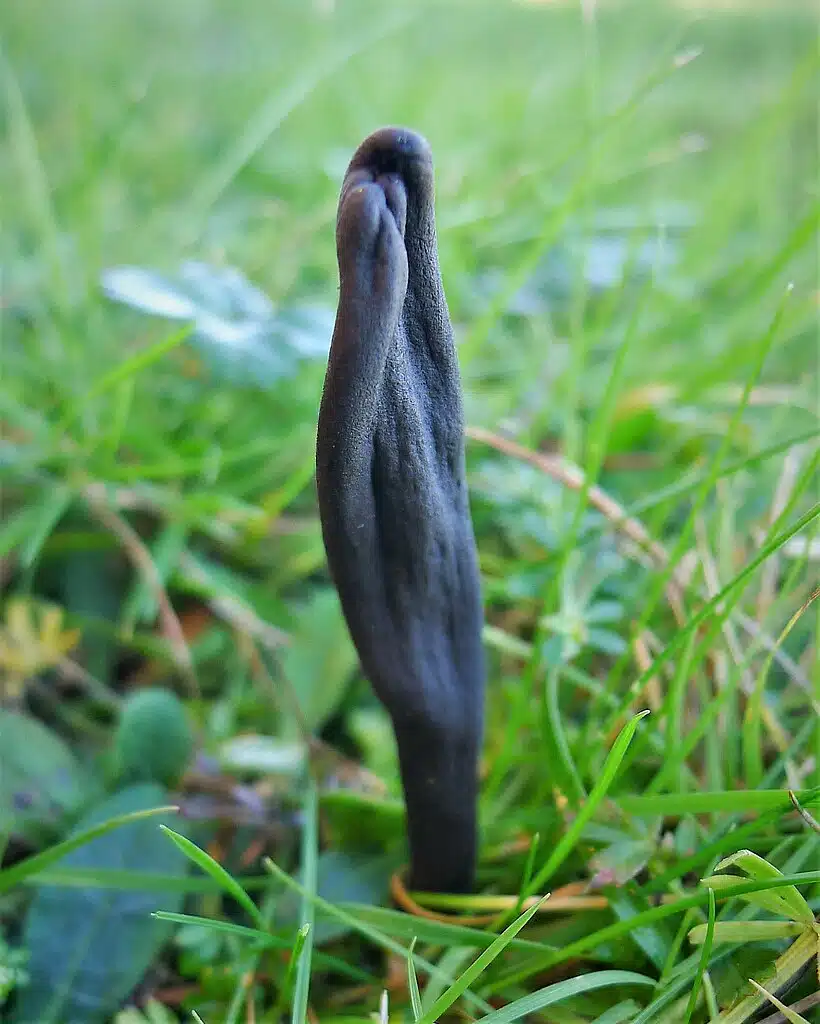
Black sections – all-black
Some types of mushrooms are completely black. Such examples are seen with the all-black Hairy Earthtongue (Trichoglossum hirsutum).
Named after its tongue-like shape, this is a black species that grows in clusters.
Some of its favorite areas to thrive include the woodlands West of The Rocky Mountains.
Hairy Earthtongues have a narrow profile and a short height as they grow to a size between 2 and 4 inches.
They maintain the tongue-like shape throughout their growth stages as they don’t have a classic cap.
Some of the habitats it prefers include pine woodlands where it grows on the ground.
It also grows on sandy soils and on the beaches around The West Coast.
Hairy Earthtongues have a long season that starts at the beginning of the summer and may even last up until November.
While growing patterns can differ, the species appears in clusters of even tens of fungi of various heights.
It is black from an early stage also showing fine and scarce white hairs.
9. Sooty Cup
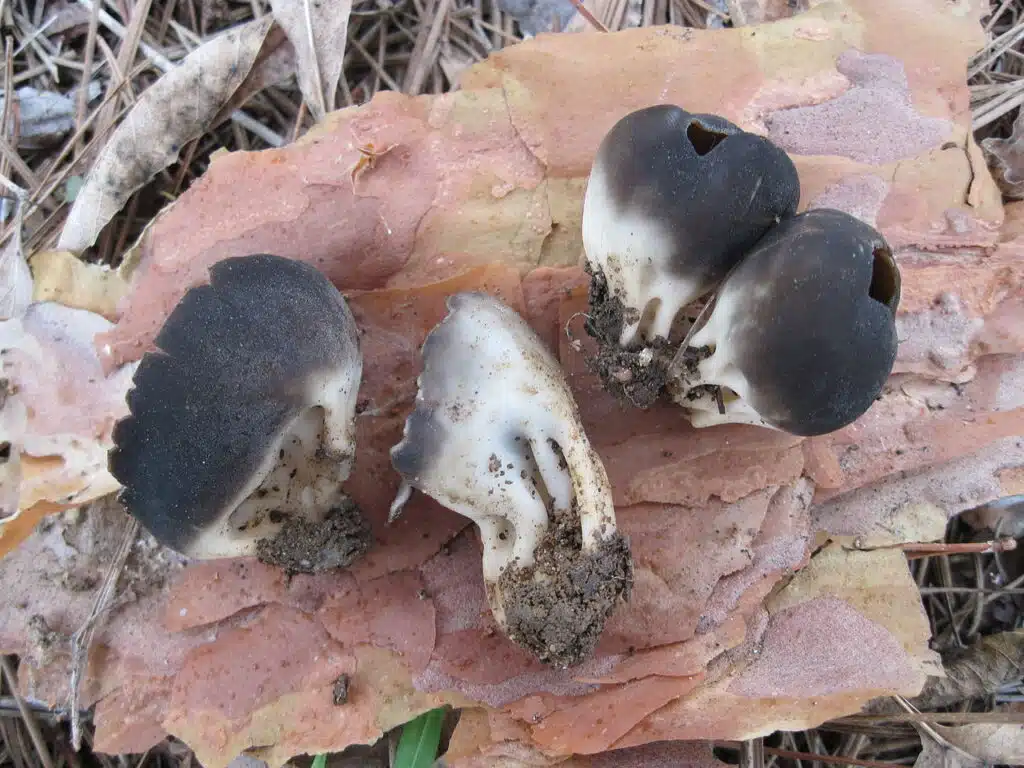
Black sections – outer cap
A dark appearance is specific to Sooty Cup fungi (Dissingia leucomelaena) but they can be black towards the top.
This type of fungi grows into the shape of a cup with changing colors through its growth stages.
The fruit bodies or the cups of the fungi are rather small, barely reaching a diameter of 1.2 inches even with the largest types of Sooty Cups.
While the cup is dark, the short stipe of the species is not but not visible. Its stipe is covered with leaf litter or soil as they grow close to the ground.
Areas west of The Rocky Mountains are the places where these cup-shaped fungi grow in North America.
They can be found in an extensive habitat from California to Alaska.
Its range around the world is also expanding. The coniferous woodlands of Europe are also a preferred habitat for the species.
10. Dewdrop Mottlegill
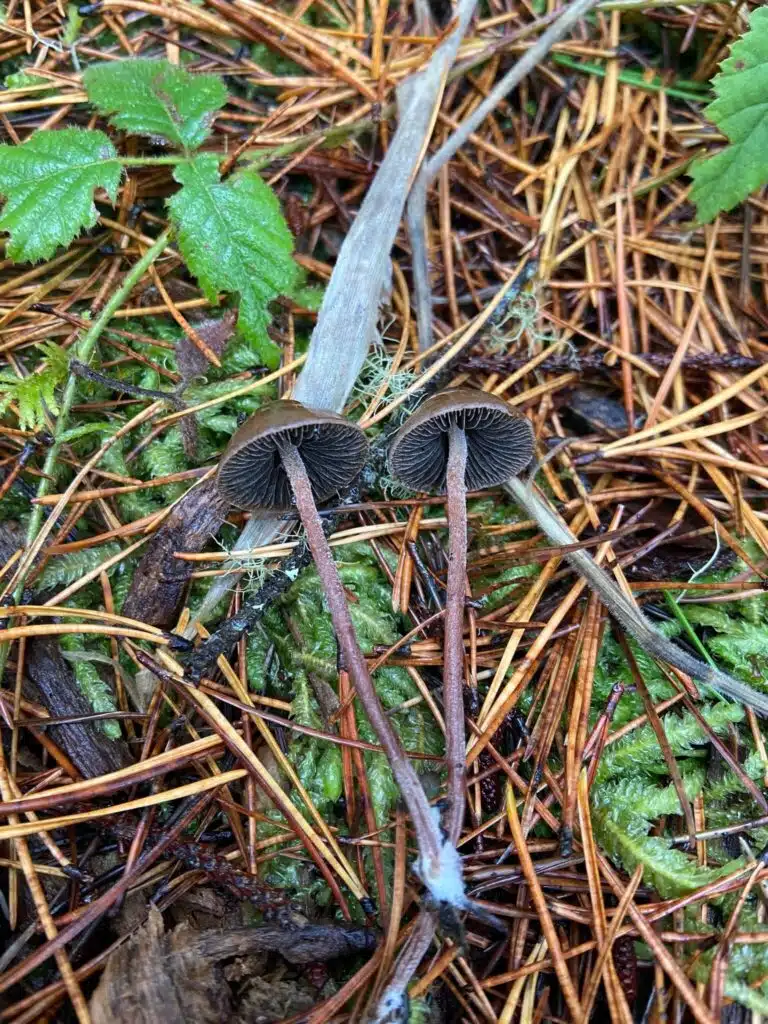
Black sections – gills
Variable coloring best describes the appearance of Dewdrop Mottlegills (Panaeolus acuminatus). This is a species that shows cream, white, brown, and black nuances.
Black gills tend to be dominant in all of these nuances. A dark type of mushroom, Dewdrop Mottlegills are also known for their elongated shape.
A long thin stipe that reaches a height of several inches holds a small cap that changes its appearance from bright to dark as it ages.
Woodlands and grasslands are home to these types of mushrooms which tend to grow in small groups.
They are found across Europe and North America and should not be picked.
These mushrooms are poisonous. While it takes eating at least a few Dewdrop Mottlegills to get sick, they can also show severe side reactions even from the first few bites.
11. Blackedged Shield
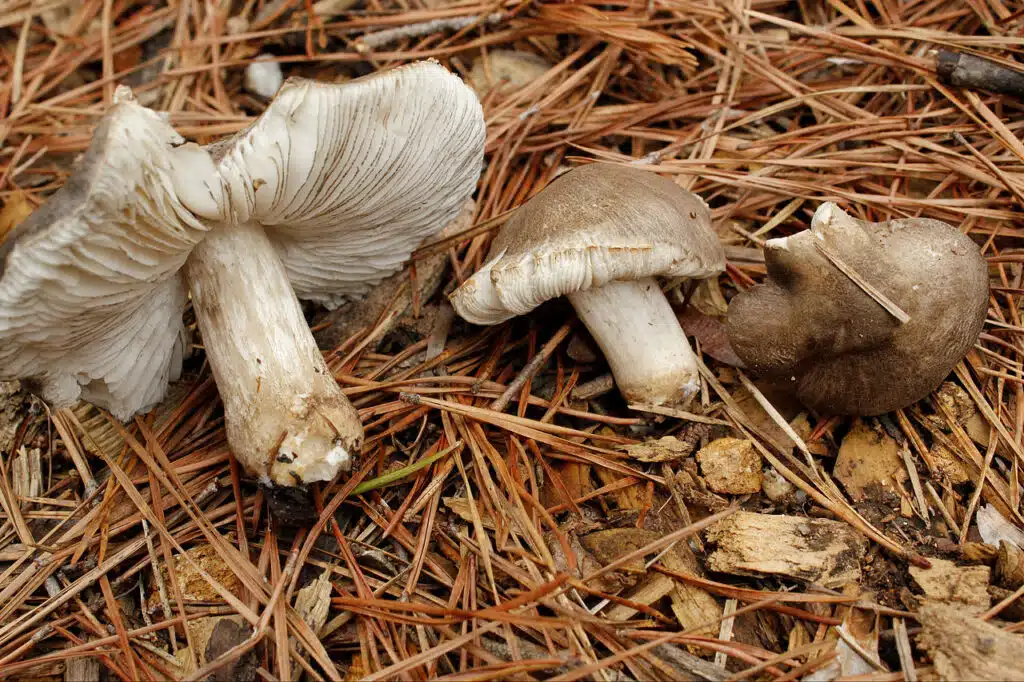
Black sections – cap
A black cap is specific to the later stage Blackedged Shield (Pluteus atromarginatus).
This species has a brown cap which darkens over time while the stipe remains white.
Decaying pine trees and pine tree timber that’s starting to decay are the most common areas to spot the species.
They can be found both in forests and around the home, especially in old pine-made cabins.
The edibility of Blackedged Shield fungi comes with mixed reports. Most reports show it might be edible.
However, these are mixed reports, as are those about the type of timber the fungi grow on.
Apart from pine, it turns out the fungi can also grow on other types of softwood.
12. Elfin Saddle
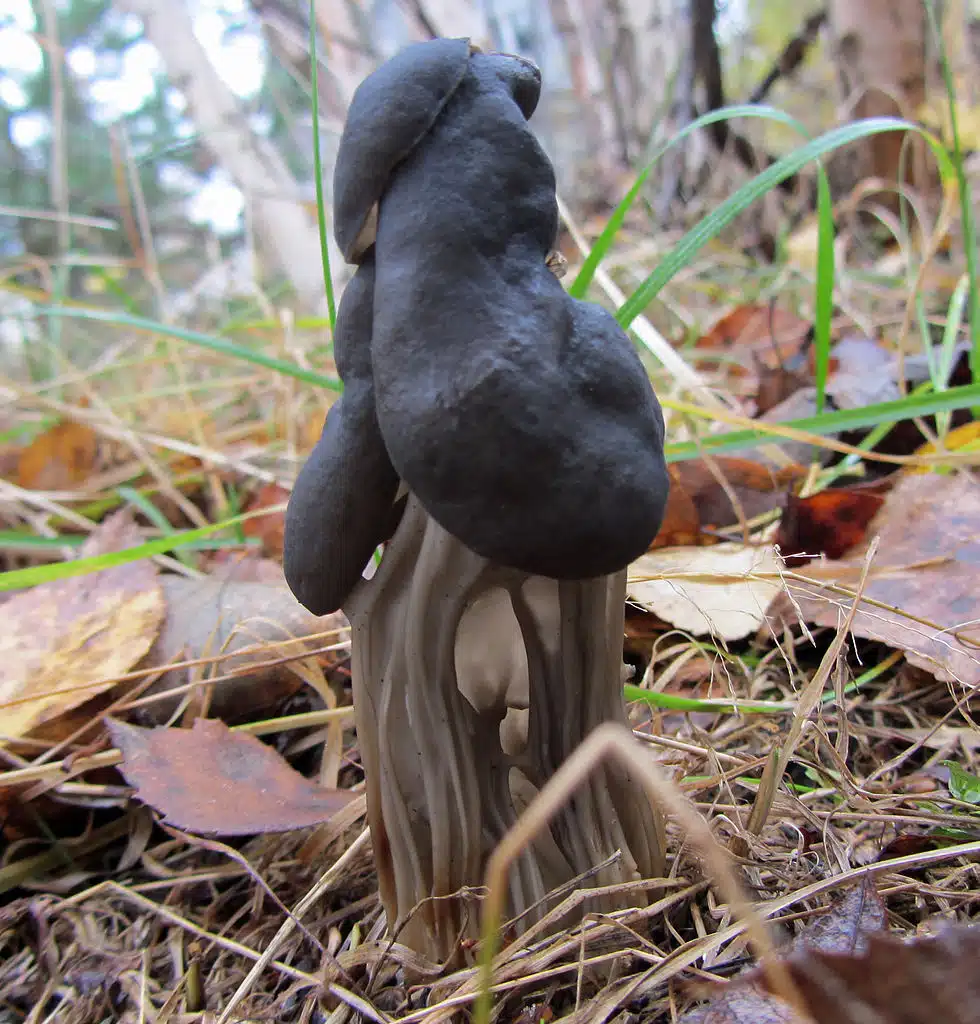
Black sections – cap
Like many Helvella mushrooms, Elfin Saddle (Helvella lacunosa) may show a different nuance as they grow.
The cap can go from gray to black but these types of mushrooms are particularly known for their wavy caps at first.
An irregular-shaped cape may make these mushrooms look dangerous or poisonous. Reports show these types of mushrooms are different, on the other hand.
Their caps may be edible, mainly after being cooked, much like other mushrooms of this species.
Growing in Europe and in North America, Elfin Saddles are found next to deciduous or coniferous trees.
The mushroom fans’ community mostly finds Elfin Saddles in coniferous woodlands.
Some of the reports of the community also state the mushroom isn’t worth picking.
Its worthlessness is mainly attributed to its small size (a cap of up to 2 inches), its chewy stipe, and its possibly poisonous nature when eaten uncooked.
13. Blue Edge Pinkgill

Black sections – all-black
A species of moorland or of upper altitudes, Blue Edge Pinkgills (Entoloma serrulatum) are also found in woodlands at times.
This is a species with an initial tan or gray color which darkens to charcoal or to an all-black appearance.
Both the cap and the long thin stipe of the species become black, while the gills remain white.
Blue Edge Pinkgills are often found along hiking paths and roads as they have a very long season into late fall.
By most reports, Blue Edge Pinkgills aren’t edible. This is a species that is even reported as possibly poisonous so it’s best not picked even if it can be found across many European pastures.
14. Dead Man’s Fingers
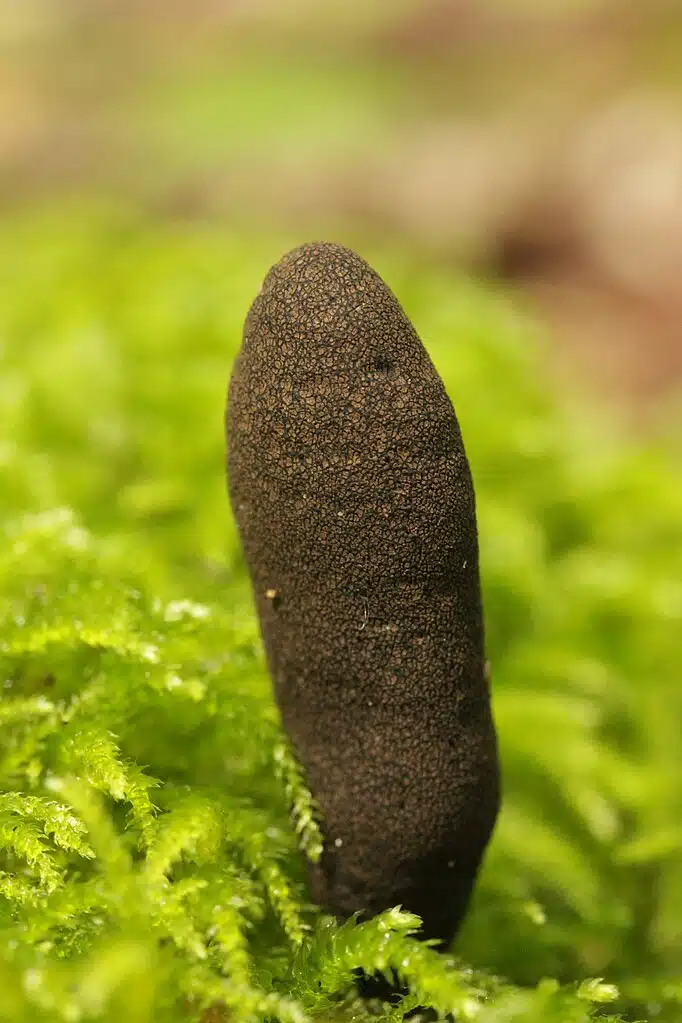
Black sections – fruit bodies
Variable coloring is specific to Dead Man’s Fingers (Xylaria polymorpha), a species named after their finger-like shapes that come out of the ground.
The fruit bodies of these mushrooms can be dark brown or all-black. They can also turn black from an initial brown color.
Fruiting bodies can take on different shapes on these fungi. For example, they can look unitary or separate into multiple small finger-like stipes.
Mostly found in deciduous forests, this is a species that grows on decaying vegetation.
Old dead roots or decaying trees are among the surfaces the fungi grow on.
Often tongue-shaped, these fungi may appear to be growing on the ground but they also arise from buried branches.
Spotting them is easy as they tend to grow in large groups. Tens and even hundreds of these fungi with their fruiting bodies can be counted on some dead trees.
Dead Man’s Fingers are inedible and grow for months from spring to fall.
15. Common Stinkhorn

Black sections – gleba
Known for its erect growing pattern and stinky nature, The Common Stinkhorn (Phallus impudicus) is a species that shows a black gleba when it’s time to spread its spores.
This is a species that also stinks badly, mainly when it’s time to spread its spores.
A particular rotting meat smell is specific to the species which attracts hundreds of spore-spreading flies.
Common Stinkhorns are spotted both in temperate and warmer subtropical climates of the world.
They are known for their widespread European distribution and for their Western US distribution.
However, Common Stinkhorn is also found in China as well as in multiple Central American countries.
All of the mushrooms in these spaces spread by attracting flies. Their exact mimicry of a carrion stench means only flies that breed and feed on carrion are attracted to them around the world.
Sometimes spotted in rarer habitats such as in coniferous woodlands, Common Stinkhorns have a long growing season up to late fall.
16. Cramp Balls
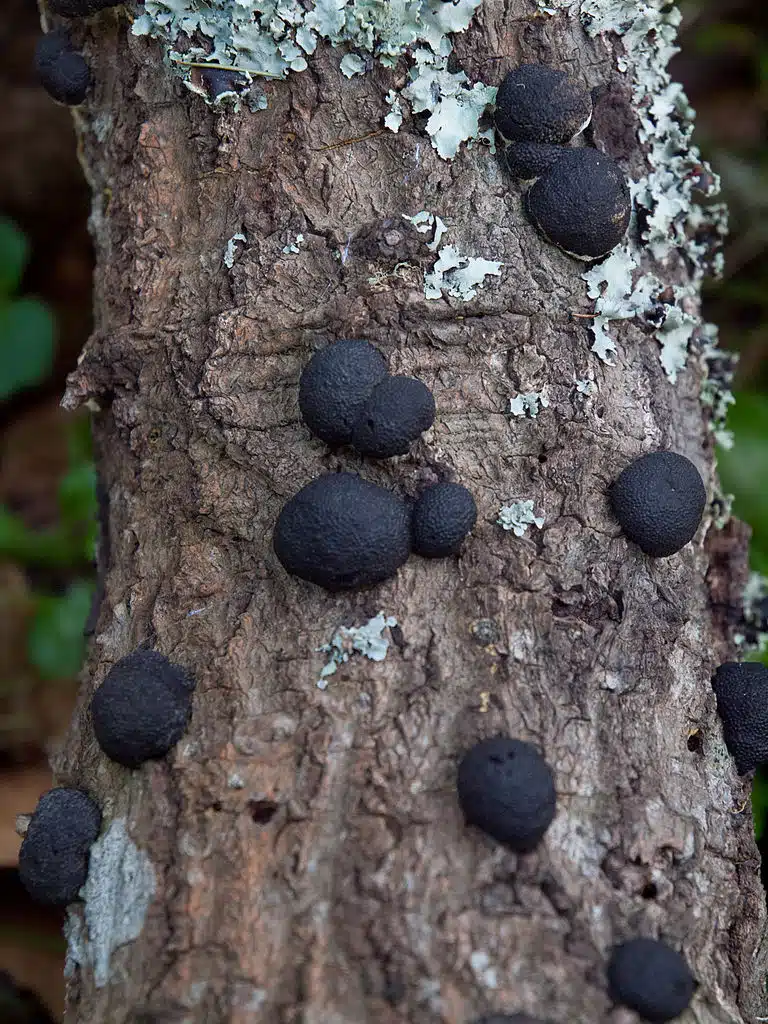
Black sections – all-black
Cramp balls (Annulohypoxylon thouarsianum) are types of fungi that grow on trees with an all-black globular shape.
This is a species with small holes on the surface and a short stipe that doesn’t really stand out.
These Cramp Balls aren’t edible. They do have various uses, particularly in Chinese medicine.
Some of the particular traits of the species include only growing on oak trees. They are seeds on dead or dying oak trees but tend to be more numerous on an oak tree that’s been dead for a long time.
While these fungi do have a globular shape, they may be more difficult to distinguish individually when growing in groups as they merge into each other over the surface of the dead tree.
17. Ravenel’s Stinkhorn
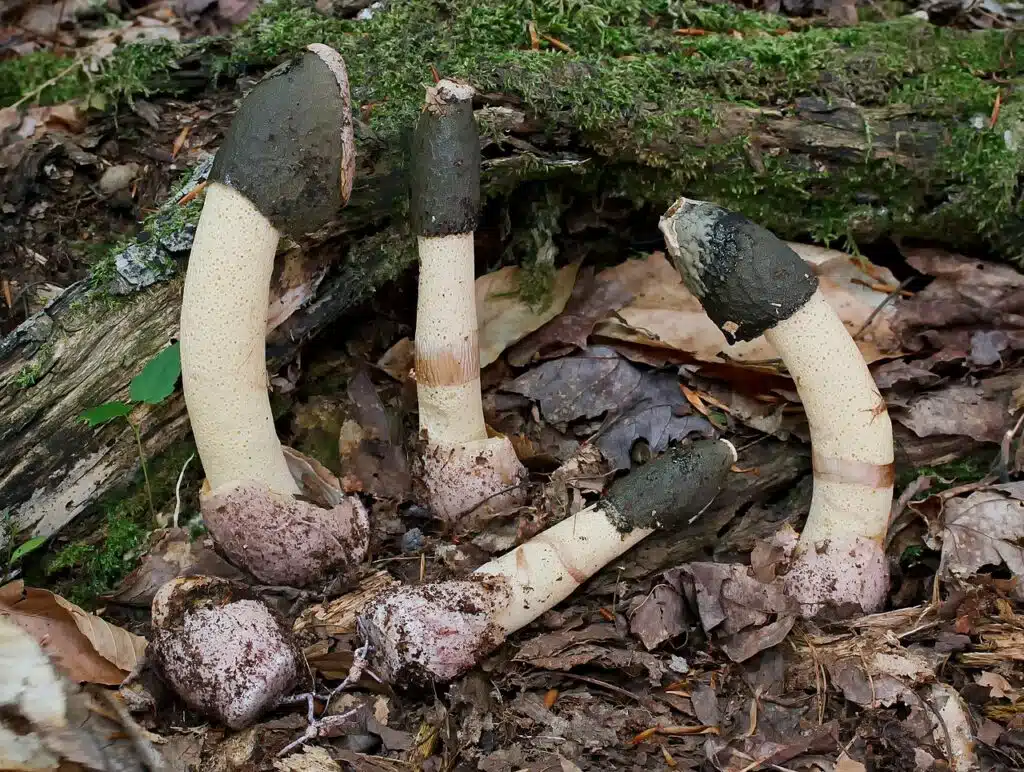
Black sections – cap
Almost any type of habitat can be suitable for Ravenel’s Stinkhorn (Phallus ravenelii). From woodlands to gardens, this is a species that grows on decaying wood easily.
Even old sawdust can trigger the growth of this species, albeit smaller and shorter.
Initially pink, this species turns olive and then dark olive on its cap before eventually turning black.
The dark cap of the mushroom is also responsible for the unlikely smell of the species that attracts flies.
As a large type of mushroom, this type of stinkhorn grows to a height of up to 9 inches.
According to some reports, it can be eaten in its early days when it emerges in a round egg-like shape.
18. Magpie Inkcap
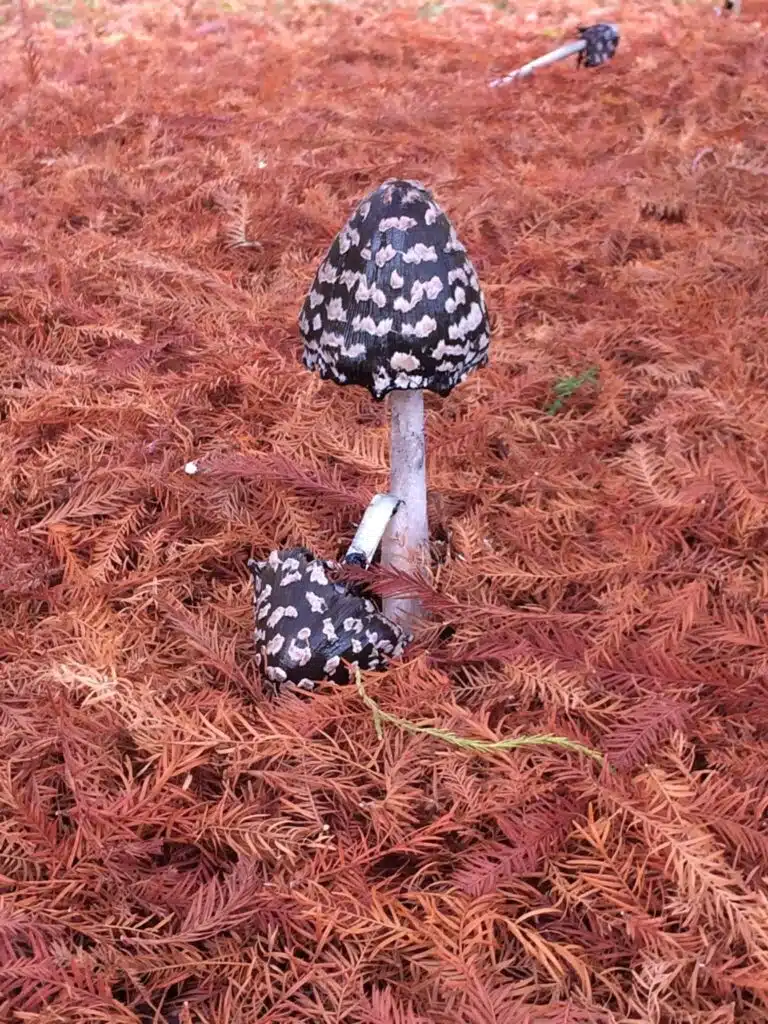
Black sections – cap
One of the most attractive types of black mushrooms is Magpie Inkcaps (Coprinopsis picacea). Known for their bell-shaped cap, this is a species that’s mostly black with white-silver patterns on the cap.
Its long thin stipe has a pure white nuance.
Beech trees and beech woodlands are among the favorite places of these mushrooms.
Easy to identify based on the black nuance of their caps with white pattern, this is a species that’s also tall, with a cap height of up to 4.7 inches.
Mostly growing on its own, Magpie Inkcaps are believed to be poisonous.
These types of mushrooms aren’t a common sight even in Europe and Australia, continents where they are found in their highest numbers.
A short life is also specific to the species which does have a long season. Some even break under the weight of the cap as the stipe itself is wobbly.
19. Dead Moll’s Fingers

Black sections – all-black
Named after its finger-like shape, Dead Moll’s Fingers (Xylaria longipes) go from bright pink to all-black as they grow.
These mushrooms have an erect straight or curved growth pattern and may reach a maximum height of up to 3 inches.
Even short scarce hairs cover this species in its early days before turning black. Once it’s black, the mushroom shows small wart-like formations on its surface as it isn’t completely smooth.
No particular odor is specific to these mushrooms which show white flesh and an inedible status.
Sycamore is among the trees it grows on as Dead Moll’s Fingers are restricted to dead trees.
They grow both in Europe and North America and can cover tree branches in large groups or clusters.
At first, round-shaped finger-like fruit bodies appear on the dead trees. Progressively, these fruit bodies turn black but also diminish in diameter looking drier.
The growing season of the species is typical of the summer months and the first weeks of the fall.
Regardless of its growth stages, the mushroom cannot be eaten as it doesn’t have a good taste and because its white fleshy is gum-like.